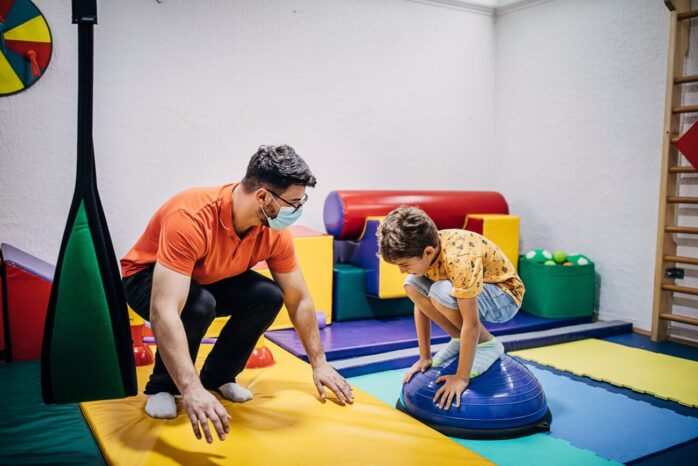
As a parent, you want only the best for your child. That includes setting them up for success so they may prosper long into adulthood. One way you can do this is by selecting the proper physical therapist. In many cases, children have renewed freedom and better opportunities when a pediatric physical therapist is utilized to address developmental problems or injuries incurred at a young age. Whether you’re curious or unsure about engaging your child in physical therapy (PT), read on for our best tips.
Who Benefits From Pediatric Physical Therapy?
Before we delve into how to choose the right therapist for your child, let’s look at who might be a good candidate for therapy. To help with that, here are some issues a pediatric physical therapist commonly addresses:
- Delays in child development
- Developmental conditions such as cerebral palsy, autism, or Down syndrome
- Muscle weakness (known as hypotonia)
- Recovery from injuries
- Skeletal developmental issues
- Other compromising conditions, such as toe walking, muscular dystrophy, or spina bifida

Tips on Choosing the Best Pediatric Physical Therapist
Now that we’ve covered some conditions a pediatric physical therapist may treat, let’s get down to our best tips for choosing the right therapist or practice for your young one.
Ask Your Pediatrician: In many cases, your primary pediatrician or family doctor can make a referral to a reputable pediatric PT provider. This is often the best place to start because your pediatrician should already have a keen understanding of your child and their situation.
Check With the American Physical Therapy Association: The APTA is a non-profit organization that is devoted to connecting children and adults in need of PT with reputable, licensed, qualified providers belonging to the association. They are based in Virginia, so they are well-versed in pediatric physical therapy in Alexandria VA – but the APTA is also a national organization and can help connect you with pediatric PT practitioners all around the US.
Talk to Friends and Family: Some of the best recommendations for qualified and trustworthy pediatric PT come from the people you know. Talk to friends and family members about what your child is going through. Ask them if they know of any reputable PT providers for kids in your area. Better yet, ask if they have children who are in PT and learn more about their practice.

Location of Treatment: PT for babies and children can take place in various settings. You can narrow your search by determining if you want your child to go to a PT clinic or if there are services that can drive to your home, pre-school, daycare, or school to administer treatments. If you can decide how therapy is administered, you can better understand which PT therapist is best for your child.
Search Reviews Online: If you don’t have a primary doctor for your child, you can go online to do research on different therapists as well as read reviews from other parents. This is particularly useful if you’ve recently relocated and are unsure about different providers in your new location.
Narrow Your Search by Speciality: If your child is struggling with a specific condition, you can narrow your search by specialization. For instance, a child with cerebral palsy can benefit from a pediatric PT practitioner who specializes in this unique field. Selecting by specialty in a specific field can also help you whittle down to therapists who will know the particulars of your child’s distinct condition.
Contact Your Health Insurance Provider: If you have insurance, you can reach out to your provider. Give them the details about your child’s condition, and most insurance providers should be able to connect you with a network of pediatric service providers.

Continuity of Care and Consistency: Continuity of care is paramount in pediatric physical therapy. It’s essential for parents to ensure the therapist they choose is available for ongoing sessions and follow-up appointments. This consistency is critical for the child’s progress and achieving the best possible outcomes. Regular therapy sessions with the same therapist foster a trusting relationship, making it easier for the child to engage in and benefit from the treatment. Consistent care allows the therapist to closely monitor progress and make timely adjustments to the treatment plan, ensuring that the child’s development is always moving forward.
Child-Friendly Environment: Creating a welcoming and stimulating environment is crucial in pediatric therapy settings. Parents should visit potential therapy facilities to check for a child-friendly atmosphere that includes age-appropriate toys, colorful decorations, and engaging activities. Such an environment can significantly enhance the child’s comfort and willingness to participate in therapy sessions. An inviting space encourages exploration and learning, making therapy feel less like a chore and more like playtime, which is essential for the child’s emotional and psychological well-being.
Involvement in Treatment Planning: Involving parents and, when suitable, the child in the treatment planning process is key to successful pediatric physical therapy. Therapists who value parental input and integrate family goals and preferences into the plan foster a more personalized and effective treatment approach. This collaborative decision-making process ensures that therapeutic goals align with the child’s needs and family’s expectations, enhancing satisfaction and compliance with the therapy regimen.
Accessibility and Accommodations: Accessibility and accommodations for children with special needs or mobility issues are critical considerations. Parents must discuss any specific needs their child might have to ensure the therapy setting is equipped to provide a conducive and safe environment for treatment. Whether it’s physical accessibility or the need for specialized equipment, ensuring these needs are met is crucial for the child’s active participation and engagement in therapy sessions.

Educational Resources and Support: Choosing a therapist or practice that offers comprehensive educational resources and support for parents is invaluable. Guidance on at-home exercises, strategies to support the child’s progress outside of therapy sessions, and access to informational materials can empower parents to contribute positively to their child’s development. This support extends the benefits of therapy beyond the clinic, enabling a holistic approach to the child’s physical well-being.
Final Thoughts About Selecting a Pediatric Physical Therapist
As you can see, you have many options to choose from when getting the best care for your child. Ultimately, your choice should depend on your child’s needs, of course, but also on your needs. And please remember that if you are dissatisfied with one therapist, you’re not stuck. You can always opt to take your child to a different provider. We wish you the best of luck in the care of your child, and we hope these suggestions help you search for qualified care providers.






